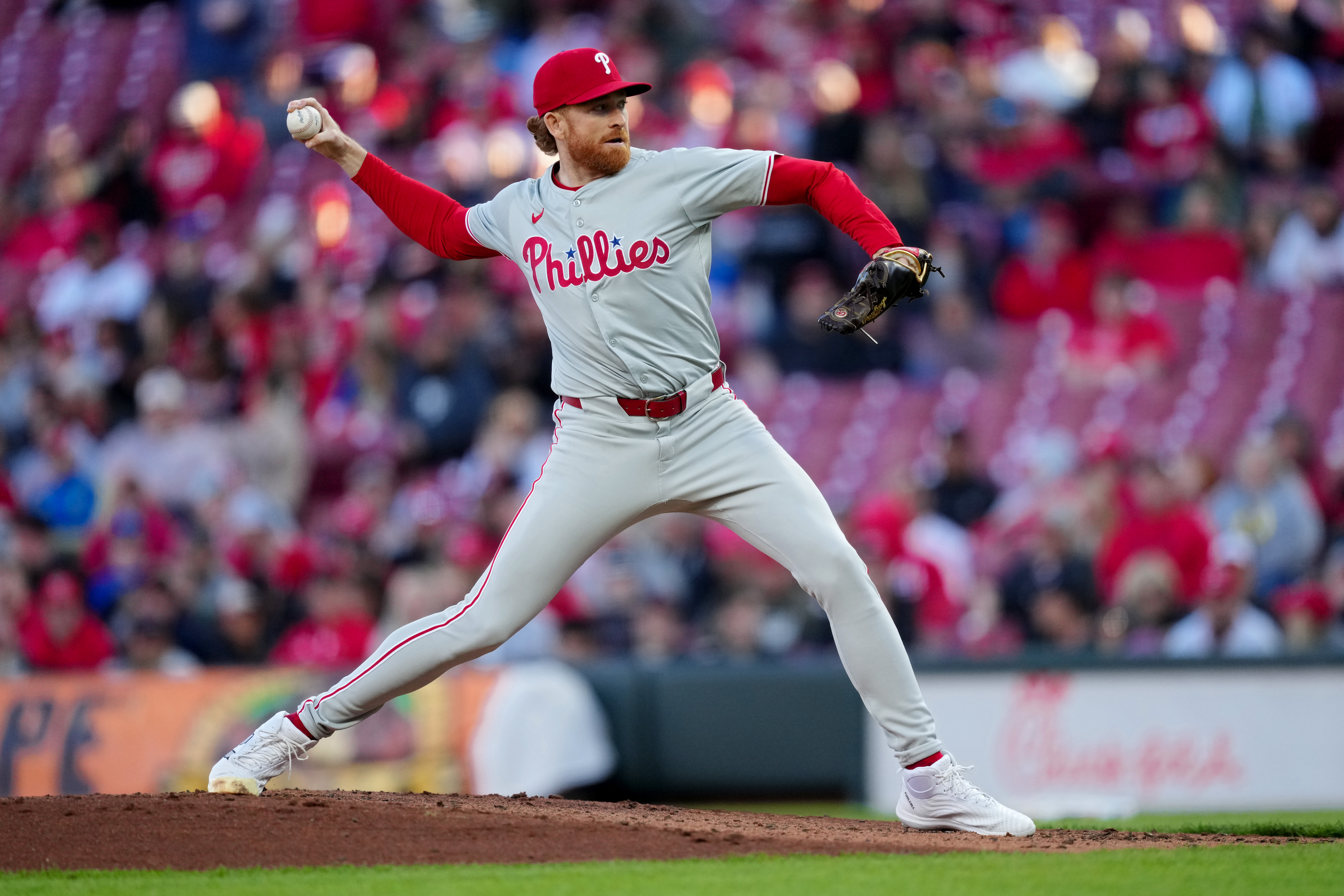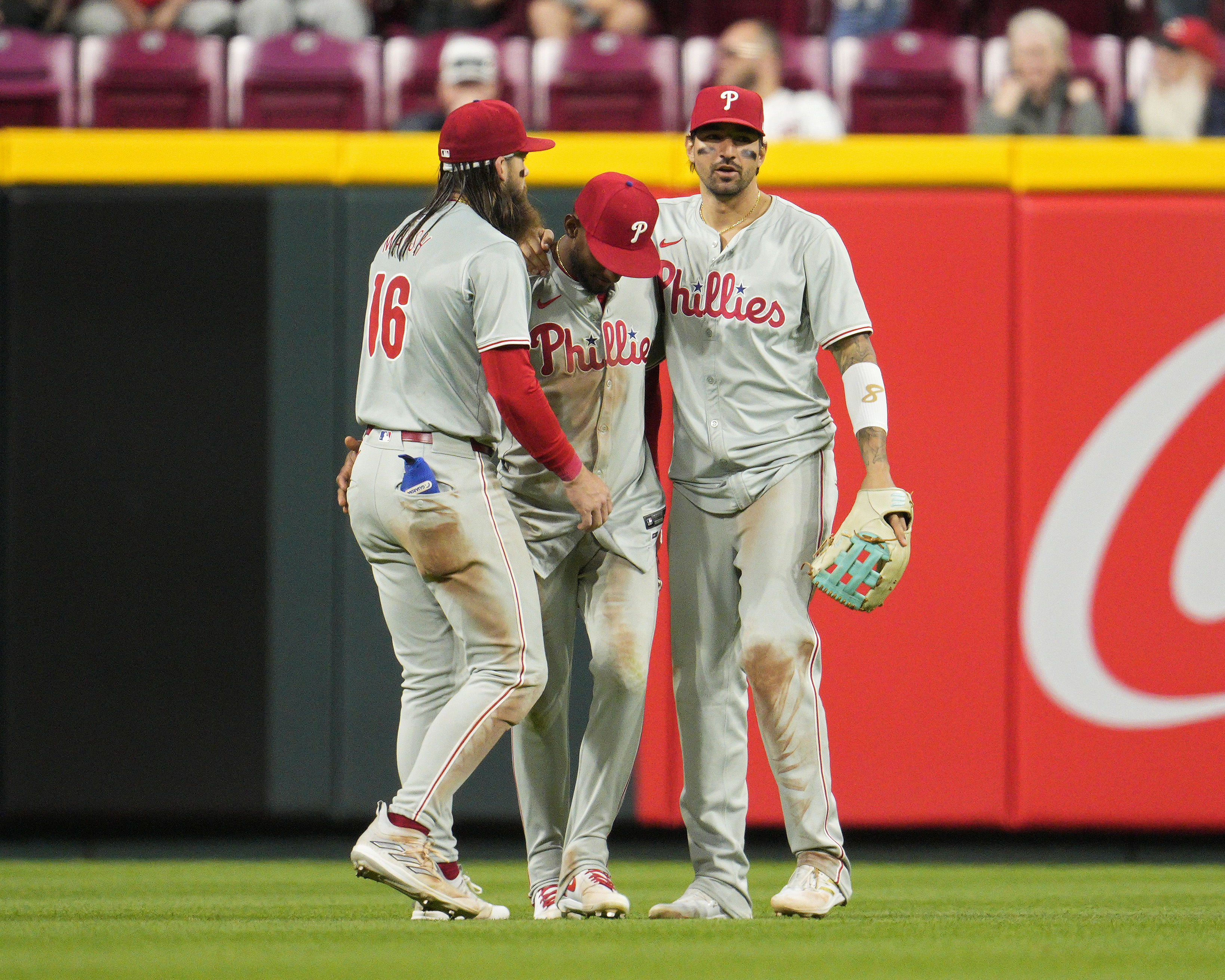The Phillies are probably going to have to adjust their organizational philosophy on the fly. Because the way they're set up now, "growing the arms and buying the bats" no longer makes sense.
That was the organizational philosophy Andy MacPhail brought to the Phillies, and it made sense because nothing can cripple a team worse than a couple albatross contracts to injured pitchers. Think about how bad it got for the Phillies when Roy Halladay and Cliff Lee were making close to $50 million combined to not pitch.
But all you have to do now is look at how the Phillies have performed since Rhys Hoskins arrived to realize that offense is no longer the main target. Where would a free-agent position player even fit with the Phillies? They could very well not sign a single hitter to a major-league contract this winter.
The infield
The Phillies are set at every infield position; now it's just a matter of determining the odd men out.
Hoskins is obviously the everyday first baseman moving forward.
Then comes that five-man group of J.P. Crawford, Scott Kingery, Cesar Hernandez, Maikel Franco and Freddy Galvis. Three of them will be starters for the Phillies, meaning at least one of them has to be traded.
Who gets traded?
Galvis would appear to be the logical trade candidate because his contract ends before any of the others. Next year will be his final year of arbitration eligibility and then Galvis is a free agent.
Philadelphia Phillies
Complete coverage of the Fightin' Phils and their MLB rivals from NBC Sports Philadelphia.
But here's the thing: If the Phillies have enough offense elsewhere in the lineup, Galvis' bat is less of a liability. The Phils could just bat him eighth and use his Gold Glove-caliber defense to aid their pitching staff.
Plus, because of Galvis' contract status, the Phillies would get more in a trade of Franco or Hernandez than they would by moving Galvis.
There are financial reasons why keeping Kingery in Triple A for four to six weeks to begin 2018 would benefit the Phillies long-term, so you might see only one of those additional infielders traded in the offseason.
A logical scenario would seem to involve opening next season with Kingery at Triple A and Franco at third. Then, after that month is up, making a decision on Franco. Best-case scenario, Franco hits eight homers in April and builds enough trade value to entice another team. Worst-case scenario, Franco doesn't hit, doesn't have trade value and the Phillies have to just move him to the bench. Then it's just a matter of whether Kingery or Crawford plays third.
In any event, the Phillies are set up for years in the infield.
The outfield
With Odubel Herrera, Nick Williams and Aaron Altherr, the Phillies are finally set in the outfield and do not need to go out and pay a veteran an eight-figure annual salary.
There are injury concerns with Altherr, who has missed a lot of time the last two years because of the wrist injury in 2016 and a few hamstring strains this year. But that doesn't mean the Phillies are going to pursue an outfielder who will command an eight-figure annual salary.
The only scenario in which I could see the Phillies paying for another outfielder is if they use Altherr as a trade chip to get a young starting pitcher. Say an offense-starved team like the Giants pursues Altherr. The Phillies could swap him for a pitcher and then use their oodles of payroll space to sign a more proven outfielder. They don't have to do it by any means, but it's an option because paying a position player for past performance often works out better than paying a pitcher.
Free-agent starting pitchers
This is where the Phillies absolutely, positively have to spend money this winter. I don't mean the top tier of Yu Darvish and Jake Arrieta. Instead, I'm referring to the second tier of Alex Cobb, Lance Lynn and perhaps Jhoulys Chacin.
The guess here is that Darvish gets at least $20 million per year and Arrieta gets between $15 million to $17 million. It doesn't make sense for the Phillies to spend that kind of money for guys whose best remaining years will be in 2018 and '19.
But pitchers like Cobb (30 years old) and Lynn (31) will command less money. They might be obtainable for something like four years, $56-60 million. Or the Phillies could go for a three-year deal with a slightly higher AAV.
Right now, the Phillies have one starting pitcher they can feel completely confident in moving forward: Aaron Nola. Jerad Eickhoff and Ben Lively look like decent options as the Nos. 4 and 5 starters but not much more. Vince Velasquez is back to square one. All Nick Pivetta has done is look like a guy destined for a late-inning relief role.
If the Phillies were to sign Cobb and Lynn, they'd have their Nos. 2 and 3 starters. The rotation would look a whole lot better, and Pete Mackanin could feel comfortable that three out of every five days, he'll have a starting pitcher who can go at least six innings.
Cobb is 11-9 with a 3.59 ERA and 1.21 WHIP this season. He's not a big strikeout guy (6.4 per nine), but he does a very good job of limiting walks. And despite his penchant for being around the plate, Cobb has never allowed a hit per inning in a full season. He has a career ERA of 3.48 in 113 starts with Tampa Bay.
Lynn, aside from missing all of 2016 after Tommy John surgery, has been a model of consistency for the Cardinals since 2012. In 180 career games (158 starts), Lynn is 72-46 with a 3.30 ERA and 8.4 strikeouts per nine innings. He's a quality start machine.
Making the money work
The only player the Phillies have under contract next season is Herrera, who makes $3.35 million next year. The Phils are also on the hook for $2.5 million of Cole Hamels' money (still), bringing their total payroll commitments next season to just $5.85 million.
Then you add in the arbitration raises for Galvis, Hernandez, Franco, Cameron Rupp and Luis Garcia (even though the Phillies are highly unlikely to keep everyone from that group). Then you add in the rising minimum salaries for the 15 or so young players - the group that includes Nola, Eickhoff, Velasquez, Williams, Hoskins, Crawford et al.
The figure you come to after adding all of that is just under $25 million. So the Phillies would have about $30 million committed to 20 players. They have so, so much money to spend.
If they were to add both Cobb and Lynn on contracts that pay $15 million per year, that would still put them at a very low payroll number of about $60 million. So they'd still have a ton of room to pursue high-level free agents in that star-studded 2018 class, which includes Bryce Harper, Manny Machado, Charlie Blackmon, Josh Donaldson, Clayton Kershaw and others.
The standings
If Hoskins and Williams are indeed for real - and they certainly appear to be given the adjustments we've already seen them make - the Phillies could push .500 in 2018 with more pitching. If they add two guys like Cobb and Lynn and they both stay healthy, the Phils could crack 80 wins in a non-fluky manner next year.
With two wild-cards, teams that hover around .500 in July and August are still in the playoff race. I'm not ready to say the Phils can compete for the second wild-card spot next season, but they could be on the fringe of it with an eye still toward the future.
There's a lot to be excited about right now. What we're witnessing on the field in September is what Phillies fans have waited years for. It took longer than expected, but barring a catastrophic injury or two in the final three weeks of the season, it finally will give the Phillies and their fans a reason for offseason optimism.



